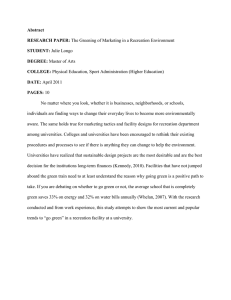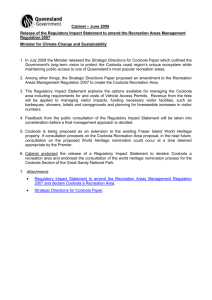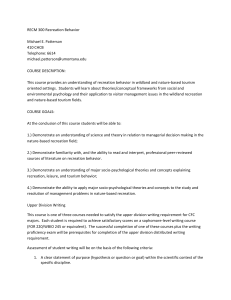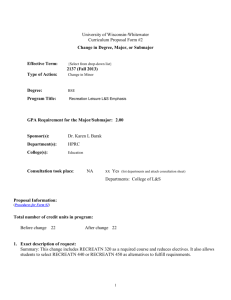I. ASCRC General Education Form Group Group VII Social Science Dept/Program
advertisement
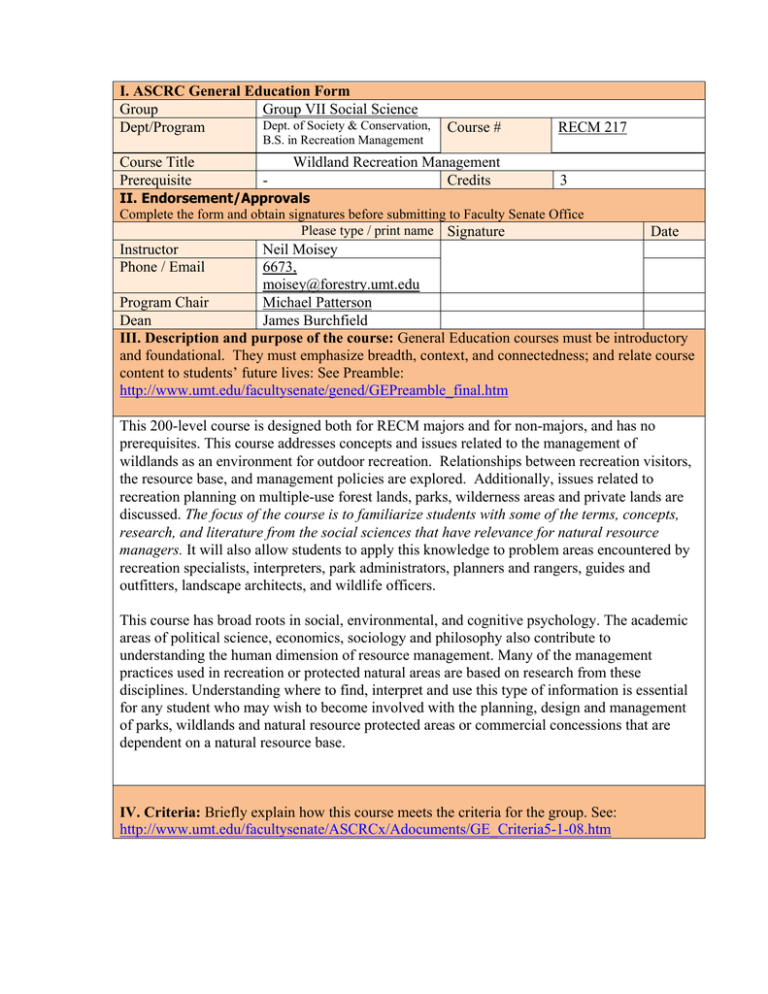
I. ASCRC General Education Form Group Group VII Social Science Dept. of Society & Conservation, Dept/Program Course # RECM 217 B.S. in Recreation Management Course Title Prerequisite - Wildland Recreation Management Credits 3 II. Endorsement/Approvals Complete the form and obtain signatures before submitting to Faculty Senate Office Please type / print name Signature Date Neil Moisey 6673, moisey@forestry.umt.edu Program Chair Michael Patterson Dean James Burchfield III. Description and purpose of the course: General Education courses must be introductory and foundational. They must emphasize breadth, context, and connectedness; and relate course content to students’ future lives: See Preamble: http://www.umt.edu/facultysenate/gened/GEPreamble_final.htm Instructor Phone / Email This 200-level course is designed both for RECM majors and for non-majors, and has no prerequisites. This course addresses concepts and issues related to the management of wildlands as an environment for outdoor recreation. Relationships between recreation visitors, the resource base, and management policies are explored. Additionally, issues related to recreation planning on multiple-use forest lands, parks, wilderness areas and private lands are discussed. The focus of the course is to familiarize students with some of the terms, concepts, research, and literature from the social sciences that have relevance for natural resource managers. It will also allow students to apply this knowledge to problem areas encountered by recreation specialists, interpreters, park administrators, planners and rangers, guides and outfitters, landscape architects, and wildlife officers. This course has broad roots in social, environmental, and cognitive psychology. The academic areas of political science, economics, sociology and philosophy also contribute to understanding the human dimension of resource management. Many of the management practices used in recreation or protected natural areas are based on research from these disciplines. Understanding where to find, interpret and use this type of information is essential for any student who may wish to become involved with the planning, design and management of parks, wildlands and natural resource protected areas or commercial concessions that are dependent on a natural resource base. IV. Criteria: Briefly explain how this course meets the criteria for the group. See: http://www.umt.edu/facultysenate/ASCRCx/Adocuments/GE_Criteria5-1-08.htm 1. systematically study individuals, groups, or social institutions; Wildland recreation management examines recreationists and their behavior as it relates to the management of natural resources. Individual behavior and the behavior of social groups are examined through their recreation choice and how that impacts the experiences of others and the underlying resources. A historical overview of societal values as they relate to natural resources provides a foundation for understanding current issues. The dynamics between social institutions, public agencies and representative groups is examined to further understand Wildland management, the preservation of societal values for natural resources, and recreational opportunities. 2. analyze individuals, groups, or social Psychological, sociological, economic, problems and structures; and/or philosophical and political theories from both a historic and modern perspective are used to fully understand the individual, and societal values for parks, recreation and nature-based tourism settings. 3. give considerable attention to ways in A historic overview of the scientific, which conclusions and generalizations are philosophical and political writings provides developed and justified as well as the methods a basis for understanding the role of nature in of data collection and analysis. society and value to the individual. Both quantitative and qualitative research data and conclusions from environmental social science literature, recreation and leisure studies, social psychology and sociology are examined in the context of their application to recreation and tourism settings. V. Student Learning Goals: Briefly explain how this course will meet the applicable learning goals. See: http://www.umt.edu/facultysenate/ASCRCx/Adocuments/GE_Criteria5-1-08.htm 1. Describe the nature, structure, and The nature, structure, and historical historical development of human behavior, development of individual and societal organizations, social phenomena, and/or values for nature and natural resources, relationships; leisure behavior, recreation and tourism management organizations, and current management challenges are emphasized. 2. use theory in explaining these individual, Psychological, sociological, economic, and group, or social phenomena; and/or political theories are used in the understanding and prediction of recreation and tourism behavior in context of managing scarce natural resources. 3. understand, assess, and evaluate how conclusions and generalizations are justified based on data Current recreation and tourism research data, both quantitative and qualitative, are examined in the context of natural resource planning, understanding recreation behavior and benefits, understanding of the changing role of communities and their involvement in natural resource management and the continuing evolving role of public agencies and their missions to uphold broader societal values for natural resources. The use of current issues provides a vehicle to integrate both the historic perspectives with more current research. VII. Syllabus: Paste syllabus below or attach and send digital copy with form. ⇓ The syllabus should clearly describe how the above criteria are satisfied. For assistance on syllabus preparation see: http://teaching.berkeley.edu/bgd/syllabus.html *Please note: As an instructor of a general education course, you will be expected to provide sample assessment items and corresponding responses to the Assessment Advisory Committee. WILDLAND RECREATION MANAGEMENT RECM 217, 3 credits MWF @ 1:10-2:00 FOR 106 Instructor: Dr. Neil Moisey Science Complex 440 243-6673 moisey@forestry.umt.edu Teaching Assistant: Dave Morris Science Complex 420 243-4325 Dave.Morris@umontana.edu Office Hours: M, F 9:00 – 12:00 or by appt. Course Description This course addresses concepts and issues related to the management of wildlands as an environment for outdoor recreation. Relationships between recreation visitors, the resource base, and management policies are explored. Additionally, issues related to recreation planning on multiple-use forest lands, parks, wilderness areas and private lands are discussed. Course Overview and Goals Much of natural resource management is really dealing with the people who use those resources and other managers and policy makers. Agencies and organizations increasingly seek professionals who can combine a knowledge of both the biophysical and the human dimensions of natural resources management. The focus of the course is to familiarize you with some of the terms, concepts, research, and literature from the social sciences that have relevance for natural resource managers. Class discussions, readings and lectures will place an emphasis on examining why recreation resources are managed as they are while providing an introduction to how they are managed. It will also allow you to apply this knowledge to problem areas encountered by recreation specialists, interpreters, park administrators, planners and rangers, guides and outfitters, landscape architects, wildlife officers - to name a few. Much of the work we will explore in this course has its roots in social, environmental, and cognitive psychology. The academic areas of political science, economics, and philosophy also contribute to understanding the human dimension of resource management. Many of the management practices we use in recreation or protected natural areas are based on research from these disciplines. Understanding where to find, interpret and use this type of information is essential for any student who may wish to become involved with the planning, design and management of parks, wildlands and natural resource protected areas or commercial concessions that are dependent on a natural resource base. Specifically, you should gain from this course: 1. An understanding of the relationships between recreationists and the environment and how these relationships are managed in wildland settings. 2. An understanding of the problems or challenges resulting from the interactions of people, resources and land managers. 3. Knowledge of how to evaluate recreation resource management decision-making (e.g. impact identification). 4. An understanding of the role of the recreation management profession in relationship to other disciplines of natural resource management. 5. To illustrate how specific concepts have been applied to natural resource settings, for example: crowding, satisfaction, conflict, values, attitudes, and norms. Required readings and resources: 1. Readings are available from the ERES site (http://eres.lib.umt.edu/eres/). 2. Additional reserve readings as assigned will be available on ERES. Requirements And Evaluation 1. Any student with learning disabilities or disadvantages needing special dispensation or assistance will inform the instructor immediately following the first class. 2. Attendance is expected, though not required. It is the student’s responsibility to cover the material missed due to absence. 3. All exams must be taken on the scheduled date. If special circumstances require a student to take the exam at an alternate date arrangements must be made with the instructor prior to the test date. Exam dates will be scheduled throughout the semester. 4. Reading: Weekly quizzes will be from the assigned readings. The readings will parallel class discussion. You are responsible for all reading material. 5. Sample exam questions: Sample exam questions are available on-line from the ERES page (http://eres.lib.umt.edu/eres/). Exams questions will come from these sample questions. Grading Total points at the end of the course will be used to determine your grade. 300 pts. Three exams scheduled throughout the semester. 100 pts. Weekly quizzes (10 points each - can drop lowest score) 20 pts. Discussion, participation, and assignments 420 pts. Total Attendance policy and classroom behavior. Students are expected to attend all class sessions, take all tests, complete all assignments both inside and outside of class. Students are responsible for all facets of the assignments which total together to form the final grade. Everyone is also expected to complete assigned readings and do research both in the library and in connection with specific agencies, businesses and individuals and possibly on the Internet. When working in groups, group members are responsible for meetings of these groups. As far as behavior in the university classroom, it is important that everyone take part in the classroom activities and discussions, and are not disrespectful of other students, faculty or guest speakers. Arriving on time and leaving on time, not engaging in excessive talking or disturbing activities in the class room, allowing for diverse opinions, are some examples of expected behavior. When meeting with public officials, business leaders, and others, students should be aware that their behavior in these professional situations reflects not only on themselves, but may also concern the university as a whole. Make up policy: Assignments must be turned in at the beginning of class on the day they are due. These due dates will be announced in class and may be listed in the Final Schedule. Late assignments will receive a 10% reduction in grade value the first week and will not be accepted after one week. In the case of a verifiable emergency (medical, family etc.) I will make every effort to work with the student - but I need to be informed as soon as possible. If the student has university excused absences for athletics or other purposes I need to know in advance to work out any make up or alternative assignments. Readings- Additional readings will be assigned! Introduction • USDA Forest Service Recreation Agenda, 2003 • • ANILCA Citizens Guide - introduction by Jimmy Carter, 2000 Ch.04: Social and Technological Forces Affecting Outdoor Recreation • Knopf, R.C. (1988). Human experience of wildlands: A review of needs and policy. Western Wildlands, Fall, 1988. Historical Contexts For Recreation • Ibrahim, H. and K.A. Cordes (1993). Chapter 1: Foundations of outdoor recreation. In: Ibrahim, H. and K.A. Cordes Outdoor Recreation WCB Brown & Benchmark Pub., Madison, Wisconsin. • Wellman, J.D. (1987). Chapter 3: Roots of policy: Romantic preservation. In: J.D. Wellman Wildland Recreation Policy. John Wiley & Sons, Inc., New York, NY. • Wellman, J.D. (1987). Chapter 4: Institutional origins: The Forest Service. In: J.D. Wellman Wildland Recreation Policy. John Wiley & Sons, Inc., New York, NY. • Wellman, J.D. (1987). Chapter 5: Institutional origins: The National Park Service. In: J.D. Wellman Wila7and Recreation Policy. John Wiley & Sons, Inc., New York, NY. • Jensen, C.R. (1985). Chapter 11: The role of state agencies. In C.R. Jensen, Outdoor Recreation in America, Fifth Ed., Burgess Pub. Co.. Management Frameworks • Jubenville, A. and B. W. Twight (I 993). Chapter 2: The outdoor recreation management model. In: A. Jubenville & B.W. Twight Outdoor Recreation Management: Theory and Application. Venture Pub., Inc., State College, PA. • Salwasser, H. (I 990). Gaining perspective: Forestry for the future. Journal of Forestry, 88(11):32-38. • Vining, J. (I 99 1). Environmental values, - emotions and public involvement. In: LeMaster, D.C. & G.R. Parker (Ed.) Ecosystem Management in a Dynamic Society, Proceedings of a conference in West Lafayette, Indiana, November 1921, 199 1, Department of Forestry and Natural Resources, Purdue University, West Lafayette, IN., pp. 27-35. • Manning, R.E., et al. (1994). The carrying capacity of national parks; Theory and application. In: Payne, R.J. and P. Nilsen (Ed.) Innovations and Challenges in the Management of Visitor Opportunities in Parks and Protected Areas. Proceedings of Workshop held at the University of Waterloo, December 1, 1994, Occasional Paper #26, Heritage Resources Center, University of Waterloo, pp. 9-22. • McCool, S.F. (1996). Limits of Acceptable Change: A framework for managing national protected areas: Experiences from the United States. Maritime Institute of Malaysia (MIMA) and Department of Fisheries Malaysia Workshop on Impact Management in Marine Parks, Kuala Lumpur, Malaysia, pp. 1-21. • Borrie, W.T. and J.W. Roggenbuck (1995). Community based research for an urban recreation application of benefits-based management. USDA Forest Service General Technical Report, PSW- 1 56, pp. 159-163. • Dustin, D. L. (I 994). Managing public lands for the human spirit. Parks and Recreation, September, 1994, pp.93-96. • Jacob, F.R. and R. Schreyer (1980). Conflict in outdoor recreation: A theoretical perspective. Journal of Leisure Research, 12,368-380. Recreation Use and Its Impacts • Hammitt, W.E. and D.N. Cole (1987). Chapter 8: Visitor Use. In: W.E. Hammitt and D.N. Cole, Wildland Recreation: Ecology and Management, John Wiley and Sons, New York, NY. • Marion, J.L. (1991). Developing a natural resource inventory and monitoring program for visitor impacts on recreation sites: A procedural Manual. Cooperative Park Studies Unit, National Park Service, Virginia Tech, Department of Forestry, Natural Resources Report NPSNRVT/NRR-91/06, Blacksburg, VA. Understanding the Recreational Visitor • Propst, D.B. and D.W. Lime (1981). How satisfying is satisfaction research? In: Forest and River Recreation: Research Update, Selected papers presented in the Forest and Rivers Content Area at the Symposium on Leisure Research, USDA Forest Service, North Central Forest Experiment Station, Miscellaneous Publication 18, University of Minnesota, pp. 124-132. • Watson, A.E. (1995). An analysis of recent progress in recreation conflict research and perceptions of future challenges and opportunities. Leisure Sciences, 17: 235-238 • Schneider, I.E. and W.E. Hammitt (1995). Visitor response to outdoor recreation conflict: A conceptual approach. Leisure Sciences, 17:223-234. • Sharpe, G.W. (1982). Chapter 1: An overview of interpretation. In: G.W. Sharpe, Interpreting the Environment, Second Edition, John Wiley & Sons, New York, NY. Issues In Recreation - Integrating Concepts of Recreation • Williams, D.R. et al. (1992). Beyond the commodity metaphor: Examining emotional and symbolic attachment to place. Leisure Sciences, 14:29-46. • Williams, D.R. (Unpublished). Mapping place meanings for ecosystem management. A technical report submitted to the Interior Columbia River Basin Ecosystem Management Project, Social Science Assessment Team. • Harmon, D. (I 987). Discussion Papers: Cultural diversity, human subsistence, and the National Park ideal. Environmental Ethics, Vol. 9, Summer 1987, pp. 147-158. • Blodgett, P.J. (I 990). Striking a balance: Managing concessions in the National Tentative Course Outline Section Date 25-Aug 1. Introduction 27-Aug 2. Historical contexts 29-Aug 1-Sep Topics Class overview and objectives Why are we here? Meanings and concepts of recreation Labor Day Holiday -- NO CLASS Benefits of recreation 3-Sep 5-Sep 3. Management frameworks Philosophical origins of land management agencies Legislative origins of land management 8-Sep Recreation management model 10-Sep Recreational Opportunity Spectrum (ROS) 12-Sep Carrying Capacity 15-Sep 17-Sep 19-Sep 22-Sep Exam 1 4. Recreation use and its impacts 24-Sep 26-Sep 29-Sep 1-Oct 3-Oct 6-Oct 8-Oct 10-Oct 13-Oct 15-Oct 5. Understanding the Recreational Visitor 17-Oct 20-Oct 22-Oct 24-Oct Limits of Acceptable Change Benefits-Based Management EM/Multiple use Conflict Models EXAM 1 Nature of impacts: visitor and resource interactions Nature of impacts: visitor and resource interactions (cont.) Soil, vegetation, wildlife and water -considerations in recreational impacts Soil, vegetation, wildlife and water – (Cont.) Monitoring setting attributes -- visitor use Monitoring setting attributes -- campsites Monitoring setting attributes -- Monitoring impacts – trails Visual resources/aesthetics Visual resources/aesthetics (cont.) Demand and motivation Demand Curve Satisfaction Readings Rec agenda & ANILCA & Ch 4 Knopf Ibrahim - Foundations of outdoor recreation Wellman Ch 3: Roots of policy Wellman Ch 4 Inst Origins USFS Wellman Ch 5 Inst Origins – NPS; Jensen State Agencies Jubenville, Recreation Model; Appx C, ROS Manning, Carrying Capacity; Haas, visitor capacity McCool, LAC; Borrie, BBM; Jacob & Schreyer, Conflict; Section Date Exam 2 27-Oct 29-Oct 31-Oct 3-Nov 5-Nov 7-Nov Topics Crowding Visitor Succession & Displacement EXAM 2 Stress and coping approach to succession and displacement Recreation specialization 10-Nov Alternative Management Approaches -Direct vs. Indirect 12-Nov Alternative Management Practices 14-Nov Use Limit Policies 17-Nov Use Limit Policies (Continue) 19-Nov Thanksgiving Holiday ‐‐ NO CLASS 6. Issues 21-Nov 24-Nov 26-Nov 28-Nov Thanksgiving Holiday ‐‐ NO CLASS Interpretation Place, Meaning and Values Place, Meaning and Values (cont.) Concessions 1-Dec Fees, Privatization and commercialism 3-Dec EXAM 3 Exam 3 5-Dec Tuesday 3:20 to 5:20 Final discussion 9-Dec Readings

